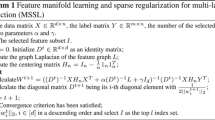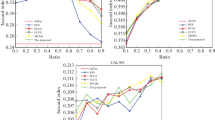Abstract
Multi-label learning deals with the problem where each instance may be associated with multiple labels simultaneously, and how to discover and exploit the label correlations is one of important research issues. In this paper, we propose a novel sparse and low-rank representation-based method for multi-label classification (SLMLC), which can automatically exploit the asymmetric correlations among labels while learning the model parameters in a unified learning framework. More specifically, we assume that the weight matrix is divided into a sparse matrix and a low-rank matrix, where the sparse and low-rank matrices are utilized to capture the specific features that are relevant to each label and the shared feature subspace among all labels, respectively. Then, we integrate multi-label classification and label correlations into a joint learning framework to learn the correlations among labels and the model parameters simultaneously. Lastly, the formulation is transformed into its convex surrogate due to its non-convexity, and we solve it by developing an alternating iterative method. Experimental results on fifteen data sets in terms of six evaluation criteria show that SLMLC achieves superior performance compared to the state-of-the-art multi-label classification algorithms.




Similar content being viewed by others
References
Zhang ML, Zhou ZH (2014) A review on multi-label learning algorithms. IEEE Trans Knowl Data Eng 26 (8):1819–1837
Schapire RE, Singer Y (2000) Boostexter: a boosting-based system for text categorization. Mach Learn 39 (2/3):135–168
Zhang ML, Zhou ZH (2006) Multilabel neural networks with applications to functional genomics and text categorization. IEEE Trans Knowl Data Eng 18(10):1338–1351
Yan Y, Wang Y, et al., Gao WC (2018) LSTM: Multi-label ranking for document classification. Neural Process Lett 47(1)):117–138
Boutell MR, Luo J, Luo JB, Shen XP, Brown CM (2004) Learning multi-label scene classification. Pattern Recogn 37(9):1757–1771
Wang C, Yan S, Zhang L, Zhang HJ (2009) Multi-label sparse coding for automatic image annotation. In: IEEE conference on computer vision and pattern recognition, Miami, pp 1643– 1650
Wang J, Yang Y, Mao JH et al (2016) Cnn-rnn: a unified framework for multi-label image classification. In: IEEE conference on computer vision and pattern recognition, pp 2285–2294
Tan QY, et al., Liu YZ, Chen X (2017) Multi-Label classification based on low rank representation for image annotation. Remote Sens 9(2):109
Qi GJ, Hua XS, Rui Y, et al. (2007) Correlative multi-label video annotation. In: Proceedings of the 15th ACM international conference on multimedia, Augsburg, pp 17–26
Janwe NJ, Bhoyar KK (2018) Multi-label semantic concept detection in videos using fusion of asymmetrically trained deep convolutional neural networks and foreground driven concept co-occurrence matrix. Appl Intell 48:2047–2066
Trohidis K, Tsoumakas G, Kalliris G, Vlahavas IP (2008) Multilabel classification of music into emotions. In: Proceedings of the 9th international conference on music information retrieval, Philadephia, pp 325–330
Zhang ML, Zhang K (2010) Multi-label learning by exploiting label dependency. In: Proceedings of the 16th ACM SIGKDD international conference on knowledge discovery and data mining, Washington, pp 999–1008
Gu Q, Li Z, Han J (2011) Correlated multi-label feature selection. In: Proceedings of the 20th ACM international conference on information and knowledge management, Glasgow, pp 1087–1096
Zhang Y, Yeung DY (2013) Multilabel relationship learning. ACM Trans Knowl Discov Data 7(2):1–30
Bi W, James TK (2014) Multilabel classification with label correlations and missing labels. In: Proceedings of the Twenty-Eighth AAAI conference on artificial intelligence, Quebec, pp 1680–1686
Huang SJ, Yu Y, Zhou ZH (2012) Multi-label hypothesis reuse. In: Proceedings of the 18th ACM SIGKDD international conference on knowledge discovery and data mining, Beijing, pp 525–533
He ZF, Yang M, Liu HD (2014) Joint learning of multi-label classification and label correlations. J Soft 25(9):1967–1981. (in Chinese)
Xu LL, et al., Wang Z, Shen ZF (2014) Learning low-rank label correlations for multi-label classification with missing labels. In: IEEE international conference on data mining (ICDM), Shenzhen, pp 1067–1072
He ZF, Yang M, Liu HD (2015) Multi-task joint feature selection for multi-label classification. Chin J Electron 24(CJE-2):281–287
Elisseeff A, Weston J (2001) A kernel method for multi-labelled classification. In: Proceedings of the 14th conference on neural information processing systems (NIPS2001), Vancouver, pp 681–687
Zhang ML, Pena JM, Robles V (2009) Feature selection for multi-label naive Bayes classification. Inf Sci 179(19):3218–3229
Hullermeier E, Furnkranz J, Cheng W, Brinker K (2008) Label ranking by learning pairwise preferences. Artif Intell 172(16):1897–1916
Furnkranz J, Hullermeier E, et al. (2008) Multilabel classification via calibrated label ranking. Mach Learn 73(2):133–153
Read J, Pfahringer B, Holmes G, et al. (2011) Classifier chains for multi-label classification. Mach Learn 85(3):333–359
Tsoumakas G, Katakis I, Vlahavas I (2008) Effective and efficient multilabel classification in domains with large number of labels. In: Proceedings of ECML/PKDD 2008 workshop on mining multidimensional data, Antwerp, pp 30–44
Tsoumakas G, Katakis I, Vlahavas I (2011) Random k-labelsets for multilabel classification. IEEE Trans Knowl Data Eng 23(7):1079–1089
Godbole S, Sarawagi S (2004) Discriminative methods for multi-labeled classification. In: Dai H, Srikant R, Zhang C (eds) Lecture notes in artificial intelligence 3056. Springer, Berlin, pp 22–30
Ghamrawi N, Mccallum A (2005) Collective multilabel classification. In: Proceedings of the 14th ACM international conference on information and knowledge management, Bremen, pp 195– 200
Chen G, Song YQ, Wang F, et al. (2008) Semi-supervised multi-label learning by solving a sylvester equation. In: SIAM conference on data mining, Atlanta, pp 410–419
Weng W, Lin YJ, Wu SX, et al. (2018) Multi-label learning based on label-specific features and local pairwise label correlation. Neurocomputing 273:385–394
Zhu Y, Kwok JT, Zhou ZH (2017) Multi-label learning with global and local label correlation. IEEE Transactions on Knowledge and Data Engineering. arXiv:1704.01415
Guo Y, Gu SC (2011) Multi-label classification using conditional dependency networks. In: Walsh T (ed) Proceedings of the 22nd international joint conference on artificial intelligence, AAAI Press, pp 1300–1305
Guo Y, Xue W (2013) Probabilistic multi-label classification with sparse feature learning. In: Rossi F (ed) Proceedings of the 23rd international joint conference on artificial intelligence, AAAI Press, pp 1373–1379
Zhang ML (2011) LIFT: multi-label learning with label-specific features. In: Walsh T (ed) Proceedings of the 22nd international joint conference on artificial intelligence, Barcelona, pp 1609–1614
Ji S, Ye J (2009) Linear dimensionality reduction for multi-label classification. In: Proceedings of the 21st international joint conference on artificial intelligence, California, pp 1077–1082
Zhang ML, Zhou ZH (2007) ML-KNN: a lazy learning approach to multi-label learning. Pattern Recogn 40(7):2038–2048
Read J (2008) A pruned problem transformation method for multi-label classification. In: Proceedings of New Zealand computer science research student conference, Christchurch, pp 143-150
Ji S, Tang L, Yu S, Ye J (2010) A shared-subspace learning framework for multi-label classification. ACM Trans Knowl Discovery Data 4(2):1–29
Chen J, Liu J, Ye J (2012) Learning incoherent sparse and low-rank patterns from multiple tasks. ACM Trans Knowl Discovery Data 5(4):1–31
Gutta S, Cheng Q (2013) Joint multitask feature learning and classifier design. In: Proceedings of the 47th annual conference on information sciences and systems, pp 1–5
Boyd S, Vandenberghe L (2004) Convex optimization. Cambridge University Press, Cambridge
Fazel M, Hindi H, Boyd S (2001) A rank minimization heuristic with application to minimum order system approximation. In: Proceedings of the 2001 American control conference, pp 4734–4739
Ji S, Ye J (2009) An accelerated gradient method for trace normminimization. In: Proceedings of the 26th annual international conference on machine learning, Montreal, pp 457–464
Acknowledgements
This work was supported by National Natural Science Foundation of China under Grants 61876087, 61502058, 61432008, the Science and Technology Research Project of Jiangxi Provincial Education Department under Grant GJJ151262, Natural Science Foundation of Educational Committee of Jiangsu Province under Grant 15KJB520002, and the Social Science Research Project of Pingxiang under Grant 2017XW02. The authors would like to thank the anonymous reviewers and the editors for their constructive and valuable comments.
Author information
Authors and Affiliations
Corresponding author
Rights and permissions
About this article
Cite this article
He, ZF., Yang, M. Sparse and low-rank representation for multi-label classification. Appl Intell 49, 1708–1723 (2019). https://doi.org/10.1007/s10489-018-1345-5
Published:
Issue Date:
DOI: https://doi.org/10.1007/s10489-018-1345-5




